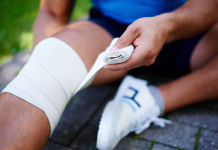It is more common than you think, as one in every three recreational runners will have a
running-related injury at some stage in their life. The common running-related injuries normally occur in the lower legs, such as the knee, ankle, shin, and foot. Sometimes, runners experience back and groin injuries too.
If you are new to running, your body may not be used to the repetitive motion and you’re
likely to end up with body aches. But that doesn’t always mean you are injured, however, it’s a signal that your body is telling you to prepare yourself from getting injured.

Image via : EmergeOrtho
There are a lot of ways you can sprain, strain, tweak and tear yourself when you are out
running. So, here’s what you will need to know as a beginner runner running for the long haul in preventing common running injuries.
Firstly, here’s some external risk factors that can increase your risk of injuries while running;
? Overtraining: Running beyond your current level of fitness can put your muscle,
tendons, and ligaments under strain. Always remember to listen to your body and take rests.
? Hard surfaces: The impact of running on hard surfaces can lead to injuries such as
shin pain, knee injuries, and stress fractures. If possible run on soft surfaces such as
on track or the field.
? Incorrect shoes: If you are running long distances, wearing the wrong type or size of
shoes can increase the risk of various injuries such as blisters or shin pain. Hence, it
is important to invest in a pair of suitable and ideal running shoes.

Image via : Mapmyrun
Now, here’s what all runners should do before running. Yes, it is warming up and including
plenty of stretches, especially on the thighs and calves muscles. Then, perform a cooldown
and incorporate stretches into your cool-down routine. As simple as warming up and cooling down properly can help prevent yourself from injuries.
To avoid targeted injuries on the legs, here are a couple of tips all runners should know;
1. Runner’s knee
It is the most common knee injury for runners also known as “Patellofemoral Pain
Syndrome”. It is a dull, achy pain underneath your kneecap and is felt during running, uphill runs, or walking up and down the stairs.
To prevent it, try working on your core and hip strength. As studies show people with knee
pain who completed six weeks of core and hip strength training reported early resolution of
pain and gained more strength.

Image via : WomensRunning
2. Shin Splint
It is known as “Medial Tibial Stress Syndrome” which causes pain on the inside surface of
the shin. The pain can occur on the inner or outer side of the shins.
To prevent it, get proper running shoes with more cushioning. However, the true fix to it is
strengthening the calves and ankle muscles.
3. Achilles Tendinitis
It is a type of tendon injury that causes inflammation and pain on the back of your heel,
especially when you’re walking, running, or stretching your calf muscles.
To prevent it, try stretching and strengthening those muscles. As there’s plenty of different
causes, to treat it properly is to see a professional.
The bottom line, while injuries are common for runners, most can be prevented. Consider
getting advice from an exercise physiologist or trainer to improve your running form and
technique to reduce your risk of injuries.
For more information please scan me (QRCode).

For further inquiry please contact us: Max 012-2969969, Christine 012-3590048 or YG
016-2020911.






























































































